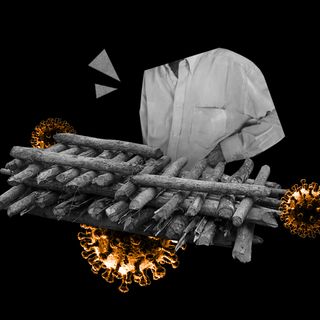Scientists from Poland have discovered a 2,000-year-old mummy — but this is no regular discovery. What makes the finding special unique is that the Egyptian mummy is pregnant, making it the first-ever pregnant mummy in recorded history.
Published in the Journal of Archaeological Science, the study documents the “only known case of an embalmed pregnant individual” — while burials of other women in ancient Egypt have been discovered before, this is the first time such a finding has been made in a mummy. The discovery, according to the researchers, “opens up new possibilities of researching pregnancy in ancient times and practices related to maternity.”
The discovery was sort of accidental. It came about when one of the researchers was double-checking the pelvis area of the mummy to establish the sex and noticed an ‘anomaly’ — a foot of the fetus. “My husband … and I looked at the X-ray images and noticed a familiar sight for parents of three children in the belly of the dead woman — a little foot!” Marzena Ozarek-Szilke, an archaeologist and anthropologist at the University of Warsaw, who was also involved in the study, told South China Morning Post.
After the discovery of the foot, scientists ran scans on the mummy and found it is indeed a female individual’s remains. Based on the tests they ran, the woman is understood to have died when she was between 20 to 30 years old, and based on the circumference of the fetus’s head, researchers estimate she was about 6.5 to 7.5 months pregnant at the time of her death. Her vital organs had been extracted from her body, embalmed, and then placed again in four bundles in her abdominal cavity. She also appears to have been buried with “rich amulets,” leading researchers to conclude she may have been of “high social standing.”
“It was absolutely unexpected… We are overwhelmed with this discovery,” Wojciech Ejsmond, the archaeologist from the Polish Academy of Sciences, who led the study, told The New York Times, adding it was like “finding a treasure trove while you are picking up mushrooms in a forest.”
Related on The Swaddle:
Cavemen Were Probably Hallucinating When They Painted on Walls, Research Says
As to why the coffin was incorrectly named, experts note it could simply have been a human error on part of antiquity dealers from the 19th Century, who frequently looted and re-wrapped mummified remains.
Historians and scientists are both equally excited about the prospects of this discovery. On the one hand, historians are enthusiastic about insights into ancient Egyptian cultural and religious practices around maternity. Scientists, on the other hand, are looking to understand more about prenatal health in ancient times, and as Ejsmond told LiveScience, “look for traces of ancient medical procedures to study the history of medicine.” In fact, Ejsmond and his colleagues are wondering whether the pregnancy itself could have contributed to the woman’s death — given that fatalities because of pregnancies or childbirth were relatively common in ancient times.
At present, the researchers are focusing on analyzing samples of preserved soft tissues to determine the mummified woman’s cause of death while they await some of the other answers.
Researchers have also begun hypothesizing why the fetus wasn’t removed from the mother’s body like her vital organs. One theory suggests that it may simply be a result of embalmers, who use chemicals on a dead body while burying to prevent it from decaying, not being able to extract the fetus without damaging the mother’s body or the fetus itself — especially given the advanced stage of the pregnancy.
The other theory is based on an ancient Egyptian belief that being named is an important step to attaining personhood. Since an unborn fetus couldn’t have been named, researchers believe embalmers may not have attempted to extract it all since they considered it to be “an integral part of the [mother’s],” whose “afterlife could only have happened if it had gone to the netherworld as part of its mother.”
There may not be any quick and easy answers to this — just like the other questions the discovery has raised. And so, the mummy has aptly been named the “Mysterious Lady of the National Museum in Warsaw.”




